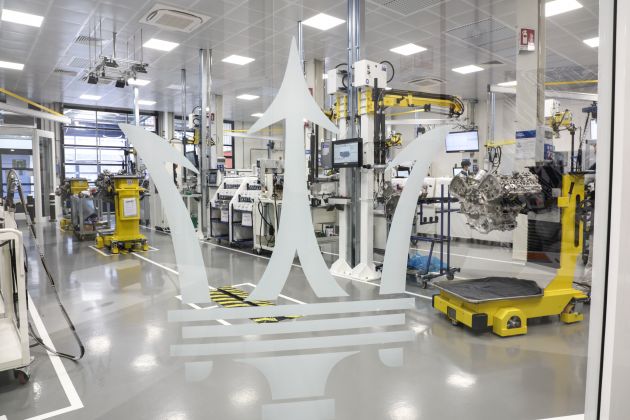Maserati Nettuno engine – getting acquainted with the 3.0L V6 heart of the new MC20 and the place its built
The Maserati MC20 is the start of a new era for the Italian carmaker, and one of the hallmarks of the super sports car is its engine, the Nettuno. Designed completely in-house, the Nettuno is the first powerplant to come out of the Maserati Engine Lab, which was newly established within the Viale Ciro Menotti plant in Modena.
Maserati recently gave us and other media outlets a virtual tour of the Nettuno’s birth place, with company chief engineer Matteo Valentini and powertrain facility manager Jonata Azzali on hand to guide us through the technical and production aspects of the new engine.
In terms of specifications, the engine is 3.5 litre twin-turbocharged V6 that makes 630 PS (621 hp) at 7,500 rpm and 730 Nm of torque from 3,000 rpm. It features a bore of 88 mm and stroke of 82 mm, with a compression ratio of 11:1, and meets several emission levels like Europe’s EU-6d, China’s 6B and USA’s ULEV 70.
With a redline of 8,000 rpm, the Nettuno also features a pre-chamber combustion system derived from Formula 1, which is necessary to hit the over 200 PS per litre target, while ensuring efficiency and reduced knocking.


Each of the engine’s six cylinders sports a pre-chamber located between the central spark plug and the main combustion chamber. While important, the pre-chamber does have drawbacks in terms of combustion stability and noise. To rectify this, there’s a secondary lateral spark plug that ensures constant ignition throughout the rev range, along with a twin-injection (port and direct) fuel delivery system.
When the engine is operating at low to moderate loads, the main spark plug in the cylinder goes to work. However, at higher loads and revs, the pre-chamber spark plug comes into play, with combustion starting ahead of the main combustion chamber before shooting out of tiny jets to spread the flame more quickly throughout the cylinder.
Maserati says the transition between the regular in-cylinder ignition and pre-chamber ignition is imperceptible, with the engine control unit responsible for alternating between the phases as well as the initiation of six-bar port (better air-fuel mixture) and/or 350-bar direct fuel injection (charge cooling). Valentini also noted that the pre-chamber requires zero maintenance.
Other characteristics of the Nettuno include a 90-degree angle between the cylinder banks, allowing the engine to be more compact (650 mm high, 1,000 mm wide and 600 mm long) when packaged into the low-slung MC20. The dry sump lubrication and outboard-mounted turbos also contribute to this endeavour, with the latter helping to keep the centre of gravity low compared to a hot internal V setup.


According to Valentini, the engine weighs around 200 kg and this is accomplished without having to resort to exotic materials like titanium or magnesium. Instead, the primary engine components like the block are made from cast aluminium, with lightweight alloys used for others. All in, the car tips the scales at just 1,470 kg for a power-to-weight ratio of 2.33 kg/PS.
Valentini added that while the Nettuno is completely bespoke and used exclusively for the MC20, the patented combustion system and other technologies from it can be applied to other engines in the future.
As for engine production, Azzali said every Nettuno is hand-built at the Maserati Engine Lab, with each unit taking about 24 hours to complete, not including testing and the time taken to fit it to the car and additional road testing.
There are six key stations that every unit must go through, with every component used (there are more than 300 used in the Nettuno) placed in specific, sealed container to ensure workers get the right parts at precisely the right station. Workers also refer to dedicated screens with detailed instructions to ensure no margin of error, with high-tech inspection equipment double checking every bolt, screw or part installed to ensure the necessary standards are met.
The white interior of the assembly area is meant to reflect the clinical precision of the engine work going on, and the whole area has its own controlled atmosphere to maintain air quality and prevent the tiniest dust particle from impairing the functionality of critical components like the prop shaft, pistons and friction bearings.
Continuous data logging is also done at every stage of engine assembly, along with testing to ensure no leakages around areas like the crankshaft. Even when fully assembled, the engine is subjected to a 40-minute dynamometer run to ensure performance remains consistent and proper operation is in order.




















The post Maserati Nettuno engine – getting acquainted with the 3.0L V6 heart of the new MC20 and the place its built appeared first on Paul Tan's Automotive News.
from Paul Tan's Automotive News
Read The Rest:paultan...




Post a Comment